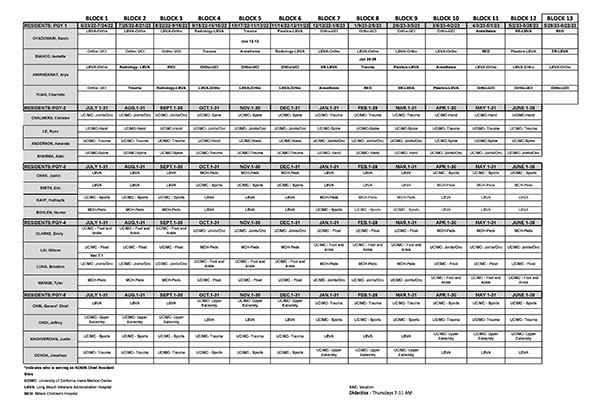PGY-II
The PGY-II year consists of a six-month trauma rotation, three-month spine rotation and three-month elective rotation at UC Irvine Medical Center. The goal of the PGY-II resident is to acquire diagnostic and clinical skills through participation in supervised outpatient clinics and through consultation in the Emergency Room. He/she is to learn total appraisal of the trauma victim, emergency room treatment of the trauma victim, the closed manipulation and reduction of fractures, and the care of a full spectrum of musculoskeletal injuries. They also learn to administer care for pre- and postoperative surgical patients. In the operating room, the PGY-II should acquire familiarity and use of all orthopaedic instrumentation and develop basic orthopaedic operative skills under the supervision of senior residents and faculty. Experience with operative care of fractures and other musculoskeletal conditions are instituted. A working knowledge of surgical approaches is required. Specific skills include application of all standard casts, splints and traction setups and basic internal fixation techniques.
The PGY 2 year is an intensive introduction to the fundamental principles of managing orthopaedic pathology, disorders and trauma. All twelve months are spent at UC Irvine Medical Center. During this time residents learn the basics of orthopaedic surgery by treating patients on the general orthopaedic services. The “R2” gets their first real introduction to the basics of orthopaedic surgical technique by spending a great deal of time in the operating room. At the end of the year, residents are fluent in the basic AO principles of fracture management, understand the biomechanics of joint reconstruction, and are able to diagnose and manage orthopaedic emergencies and trauma. Exposure to all of the subspecialties provides a foundation for the remaining years of residency and helps shape a future career path in orthopaedics.
As an R2, you are the primary surgeon with the attending walking you through the case (as long as you are well prepared and read for the case). At night, usually the senior residents will take the junior through the trauma case with attending supervision as well.
The R2 is expected to present surgical cases during the weekly didactic lecture series, as well as to participate in the different weekly subspecialty conferences. In the end of the R2 year the resident presents a research project grant proposal that will be submitted for funding.
Also, as an R2, you become very proficient in managing consults in the ED and performing reductions. There is resident clinic each week and you get exposure to non-surgical management of patients, you learn indication to operate as well as post surgical management of patients. This is an intense year but with a steep learning curve, you will become some of the best residents in the country by the end of the year.
PGY-III
The PGY-III year generally consists of one three-month rotation at Long Beach Veterans Administration, one three-month rotation at Miller’s Children’s Hospital, six months at Kaiser Permanent. During this year, the resident is to continue to develop clinical and diagnostic skills in both the Emergency Room and outpatient arena with more autonomy being allowed in the outpatient setting. Surgical skills continue to develop. Depending on the training facility at which the resident is located, and at the discretion of the attending physicians, major participation of the resident in orthopaedic re-constructive surgery such as joint replacement surgery is initiated.
The three months spent at Long Beach Veterans Administration is to prepare the residents for their transition to practice and instill a sense of confidence in their abilities to care for patients. PGY-III residents are responsible for pre and post operative care of inpatients, outpatient evaluation and management, and initial assessment and management of emergency room and in house consults. They provide first contact coverage for the service related calls and consults. They act as first assistants at surgical procedures.
Miller’s Children’s Hospital is a tertiary care center in Long Beach. Four fellowship trained pediatric orthopaedic surgeons serve as faculty members give great exposure to a wide assortment of pediatric cases for the PGY-III resident. Trauma, spine, hand, hip dysplasia, tumor and more are all included in a usual daily operative schedule. Call is split between the other 2 Long Beach Memorial Medical Center residents and is usually 1 in 4 nights.
At Kaiser Permanente, the role of the resident will be to perform major and minor operations in the capacity of primary or assistant surgeon. The resident will also participate in the initial evaluation, peri-operative care, and non-operative treatment of orthopaedic injuries and diseases, including those of the hand, and general orthopaedics. 6 months of the year is spent here with half being on the Hand service with 5 hand fellowship trained specialists, and the other half split between joint reconstructive surgery and sports medicine. Call at Kaiser is 1-2 nights per week.
Please CLICK image below to download your 2022-23 Rotation Schedule.

